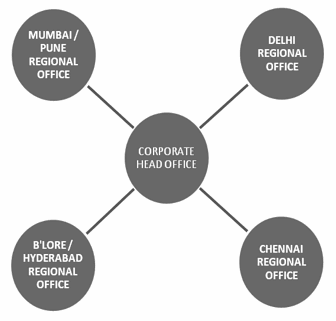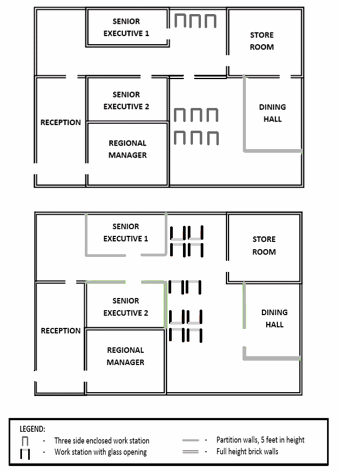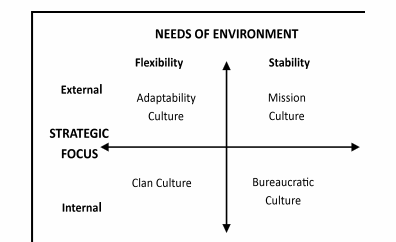Organisation Structure and Culture in an ITES Organization
Faculty Contributor: Mukta Kulkarni, Assistant Professor
Student Contributors: Parul Bajaj, Tanay Chakraborty, Mario Gonsalves, Saptarshi Mukherjee, Abhilash Sridharan
Organization theory offers valuable insights for analyzing an ITES organization. Here, a leading multi-location ITES company has been studied, with an emphasis on employee motivation, applying the principles of organization theory. Surprisingly, an informal and highly communicative culture, rather than the organization structure seems to drive employee motivation. The decision making process within the organization is found to be in line with what the theory predicts for this type of business. Certain recommendations such as creating an Ideation Centre to obtain innovative inputs from employees and changing the architectural layout are suggested for improving the performance of the company.
With the rapid growth of the IT sector, skilled manpower is the need of the hour. However, given the unpredictable nature of the market, employers are averse to ramping up manpower beyond an optimal value. To bridge the gap between the manpower resource requirements for projects currently on hand and the actual manpower available, IT companies are increasingly relying on temporary manpower as a solution; thus fueling the growth of the IT Enabled Services (ITES) sector.
The ITES sector is an interesting subject of study from an Organisational Theory perspective, given the unique nature of the business. This article deals with the key learnings gained from our study of an ITES organisation headquartered at Chennai, with regional offices at major cities, namely Bangalore, Hyderabad, Mumbai, Pune, and Delhi.
Organisation Structure
Our study showed that an organisation structure merely aided in the functioning of the organisation and was an extremely minor contributor to employee satisfaction.
Considering the multitude of organisation structures in use today – functional, product based, horizontal, matrix, and virtual, to name a few; the first step in our study was to understand the implications of a particular type of organization structure and its degree of importance in the functioning of the employees. The ITES firm that we studied was a multi-unit enterprise, with each unit having clearly demarcated verticals, such as Business Development, Business Continuity Services and functions such as Human Resources, Quality and Administration working across these verticals. Though the organisation structure lent definition to the firm by clearly demarcating hierarchies and lines of reporting, our study showed that an organisation structure merely aided in the functioning of the organisation and was an extremely minor contributor to employee satisfaction. Rather, as will be evident from the sections that ensue, an informal, highly communicative culture is the real driver behind motivation of employees.
Decision Making Processes
Our study of the decision making processes within the organization revealed that distinct levels of authority with differential empowerment for taking decisions were present. Strategic decisions, also known as non-repetitive or non-programmed decisions, related to compensation, target setting and minimum margins for new orders were taken by the corporate headquarters. These decisions were generally complex and uncertain in nature. Other more routine decisions, also known as programmed decisions, such as allocation of employees to projects, were taken by the regional managers or the heads of the regional offices. The repetitive nature of staffing and familiarity with the already established clientele were the reasons behind this delegation.
Communication & Flow of Intellect
As is the case with a majority of firms today, our study revealed that the corporate office formed the central point for receipt and disbursement of information. The regional offices communicated with each other only through the corporate office, thus preventing the formation of silos. However, since each regional office handled its own clients, valuable information was available at both the corporate office (core) and the regional offices (nodes). This is a typical example of a Starburst organization1, which is a highly leverageable organisation form, with valuable intellect at both the nodes and center, as illustrated in Exhibit 1.
“Starbursts are common in creative organizations, in environments where entrepreneurship – not merely flexible response – is critical, in ambiguous environments where estimation of outcomes in difficult.” This finds credence in the ITES sector in the face of the intense competition and turbulence rampant today. With the industry being driven by human resource, the outcomes are, indeed, unpredictable.
 Exhibit 1
Starburst Form of Organisation
Exhibit 1
Starburst Form of Organisation
Internal Communication
A comprehensive internet portal formed the crux of the communication processes within the organization under study, facilitating interaction between departments and branches. Detailed process flowcharts clearly laid out guidelines for making decisions, and the levels at which these decisions were to be made, thus minimizing the need for direct communication from the corporate office. Such an unambiguous definition of processes indicates that the roles in the organization were mechanized and a high degree of formalization existed in job descriptions. A mechanistic approach like this one is generally observed in large organizations because of the scale and complexity of processes. However, this intense formalization in roles at the organization under study was offset by the existence of a strong informal communication network between the employees, a fact attributed to the small size of this rapidly growing firm.
While the portal had extensive features for downward communication, a careful study revealed a lack of similar facilities for upward communication. As a solution, we recommended the formation of a virtual ‘Ideation Centre’ to seek innovative ideas from the employees. This utility would not only aid the growth of the organization, but would also promote ownership and meritocracy.
Architectural Implications on Communication
The architectural layout of an office can have a profound impact on communication between superiors and subordinates and with peers; an idea propounded by Thomas J. Allen2.
As part of our study of the ITES firm, we analysed the existing workstation structure and design at the Bangalore regional office. Completely enclosed cabins and workstations with opaque walls characterized the current setup. While this afforded privacy to the employees, it was a deterrent to free flow of communication.
Based on Thomas J. Allen’s study, we proposed a revised layout, involving replacement of cabins by semi-enclosed cubicles and opaque workstations by glass front cubicles. Only the regional manager’s cabin was retained, considering the need for private discussions with clients and vendors. The original architecture and the proposed modification are shown in Exhibit 2.
 Exhibit 2
Architectural Implications on Communication
Exhibit 2
Architectural Implications on Communication
Organisation Culture
Culture is the set of values, norms and guiding beliefs that is shared by every member of an organisation, and is taught to every new member. Though everyone is a part of the culture, it usually goes unnoticed due to its intangibility. Based on the demands of the external environment and the strategic focus of an organisation, Denison and Mishra 3 classified the culture at organisations into four categories – adaptability culture, mission culture, clan culture and bureaucratic culture, as shown in Exhibit 3.
However in today’s competitive and customer-driven world, it is impractical for an organisation to adopt and practice one specific culture. The ITES organisation which we studied exhibited a hybrid of an adaptability culture and a clan culture – a strategic focus on both the external and internal environments.
 Exhibit 3
Relationship of Environment & Strategy
Exhibit 3
Relationship of Environment & Strategy
Because of the extremely dynamic nature of the ITES sector, adaptability to the external environment is extremely important in order to keep abreast with the customer’s continuously changing demands and to stave off competition. A case in point was the recent shift in strategic focus of the organization from temporary to permanent placement of employees with the clients, triggered by the slowdown in the IT industry.
At the same time, given that the most important resource in the ITES sector is people, the focus is commensurately devoted to ensuring that its employees are satisfied. “The ultimate success of our organisation depends on the success of our employees at our clients’ organisations”, said one of the managers we interviewed. Thus, an amalgamation of adaptability and clan culture drove the firm which we studied – the case of hybrid cultures would be much the same with most firms today.
Fostering Organisation Culture
‘Rites and ceremonies’ are of prime importance especially in growing organizations, where there is a tendency for individuals to form interest groups, resulting in fragmentation of the organisation and dilution of the organisation culture.
While most organizations live with the belief that they are driven by a strong organization culture, in many cases there is an ocean of difference between the perception of organizational culture at the management and executive levels. Trice and Beyer 4 propose four types of ‘rites or ceremonies’ to help imbibe the organization culture in individuals – passage through induction programs, enhancement through awards and recognition, renewal through organizational development activities and integration through group activities and get-togethers. The firm we studied extensively used such ‘rites and ceremonies’ – from well-structured induction programs and annual award nights to group activities like team dinners, movie screenings, and picnics. It was interesting to note that every activity was carried out with an underlying motive of learning – for example, employees were taken for the screening of the movie ‘Chak de India’ for the fun quotient and to ensure learning through powerful messages of leadership, initiatives, and team-building.
From interviews with the employees at the firm, the impact of these activities was evident – all the interviewees perceived the organisation as people-centric and felt that these activities definitely fostered a sense of belonging. Thus, these ‘rites and ceremonies’ are of prime importance especially in growing organizations, where there is a tendency for individuals to form interest groups, resulting in fragmentation of the organisation and dilution of the organisation culture.
Conclusion
The structure of an organization is not the all-encompassing factor that determines its success. A well-defined demarcation of roles and responsibilities serves as a hygiene factor, but it is the culture and its effective dissemination amongst the employees that contribute to the cohesiveness and motivation of employees. Moreover, the co-existence of a strong informal communication network with formalized channels within the organization, expounds the importance of employee interaction and satisfaction in a rapidly growing environment.
Contributors
Mukta Kulkarni is an Assistant Professor in the Organizational Behaviour and Human Resources Management Area at IIM Bangalore. She completed her PhD in Organization and Management Studies from University of Texas at San Antonio. She can be reached at mkulkarni@iimb.ernet.in
Parul Bajaj (PGP 2008-10) holds a B.Sc. in Microbiology from St. Xavier’s College, Mumbai. She can be reached at parul.bajaj08@iimb.ernet.in
Tanay Chakraborty (PGP 2008-10) holds a B.E. degree in Instrumentation & Electronics Engineering from Jadavpur University, Kolkata. He can be reached at tanay.chakraborty08@iimb.ernet.in
Mario Gonsalves (PGP 2008-10) holds a B.E. degree in Electrical & Electronics Engineering from S.V.C.E., Anna University, Chennai. He can be reached at mario.gonsalves08@iimb.ernet.in
Saptarshi Mukherjee (PGP 2008-10) holds a B.E. Degree in Electronics and Telecommunications Engineering degree from Jadavpur University, Kolkata. He can be reached at saptarshi.mukherjee08@iimb.ernet.in
Abhilash Sridharan (PGP 2008-10) holds a B.Tech Degree in Metallurgical Engineering from the Institute of Technology, Banaras Hindu University, Varanasi. He can be reached at abhilash.sridharan08@iimb.ernet.in
Keywords
Organization Behaviour and Human Resources, IT Enabled Services, Organization Structure, Communication, Culture
References
- Quinn, Anderson, Finkelstein, 2005, 'Leveraging Intellect', Academy of Management Executive , Vol 19, No. 4, pp 78–93.
- Thomas J. Allen, 2007, 'Architecture and Communication among Product Development Engineers', California Management Review , Vol 49, No. 2, pp 23–41.
- Daniel Denison, Aneil Mishra, 1995, 'Toward a Theory of Organizational Culture and Effectiveness', Organization Science , Vol. 6, pp 204–223.
- Harrison Trice, Janice Beyer, 1984, 'Studying Organizational Cultures through Rites and Ceremonials', Academy of Management Review , Vol. 9, pp 653–659.
